Explanation
2. Mainstream definitions of food waste and food loss
3. Global statistics on food waste
4. Other understandings of food loss and waste
5. Hierarchies of food loss and waste
1. Introduction
Around one third of the weight of food produced for human consumption is lost or wasted1, and around a third of crop calories are lost to the food system during livestock production2. Meanwhile, the global food system causes significant environmental impacts and around 800 million people are undernourished3. This building block examines the following aspects of food loss and waste: mainstream definitions and alternative understandings, global statistics, and ‘hierarchies’ for prevention and treatment.
2. Mainstream definitions of food waste and food loss
Different stakeholders use different definitions of food loss and food waste, some of which are outlined below.
According to one set of definitions provided by the Food and Agriculture Organisation of the United Nations (FAO), the difference between food loss and food waste is as follows1:
- Food loss is “the decrease in edible food mass throughout the part of the supply chain that specifically leads to edible food for human consumption”, including the production, postharvest and processing stages.
- Food waste is food loss that occurs “at the end of the food chain”, i.e. during retail or final consumption.
The FAO explicitly states that it excludes both food that is intended for animal feed and inedible parts of food products from these definitions.
According to another set of definitions from the FAO4,5:
- Food loss, which “refers to all food produced for human consumption but not eaten by humans”, is “the decrease in quantity or quality of food”.
- Food waste, a subset of food loss, is the “discarding or alternative (non-food) use of food that is safe and nutritious for human consumption along the entire food supply chain, from primary production to end household consumer level.” This is different to the first FAO definition, because it is based on whether or not wasted food was safe to eat, rather than where in the supply chain that waste occurs.
The NGO World Resources Institute (WRI), which has worked extensively on this issue, defines food loss as food that has become unfit for consumption before it reaches the consumer, and food waste as the discarding of food that is fit for consumption, either before or after it spoils. The starting point used by the WRI for measuring food loss and waste is the moment that crops are ripe, animals are ready for slaughter, milk has been taken from the udder, or wild fish have been caught6. The WRI explicitly excludes from its definitions the following: by-products that could be considered unavoidable because they are not intended for human consumption within a specific supply chain (e.g. bones or peels), surplus food that is redistributed and ultimately eaten by people, food intentionally produced for feed or other non-food purposes such as biofuels, and consumption of food surplus to caloric requirements.
The Food Loss and Waste Accounting and Reporting Standard, a global standard developed by several stakeholders (including the United Nations Environment Programme, WRAP and the World Resources Institute) for measuring and reporting food losses and waste, allows flexible definitions of food loss and waste to be used according to the purpose of the measurement (see the diagram below). For example, an organisation concerned with food security might only want to measure the loss of edible food, while other situations might require the measurement of both edible food waste and associated inedible parts7 (such as when developing waste management infrastructure or seeking to understand the opportunities for extracting value from food waste).
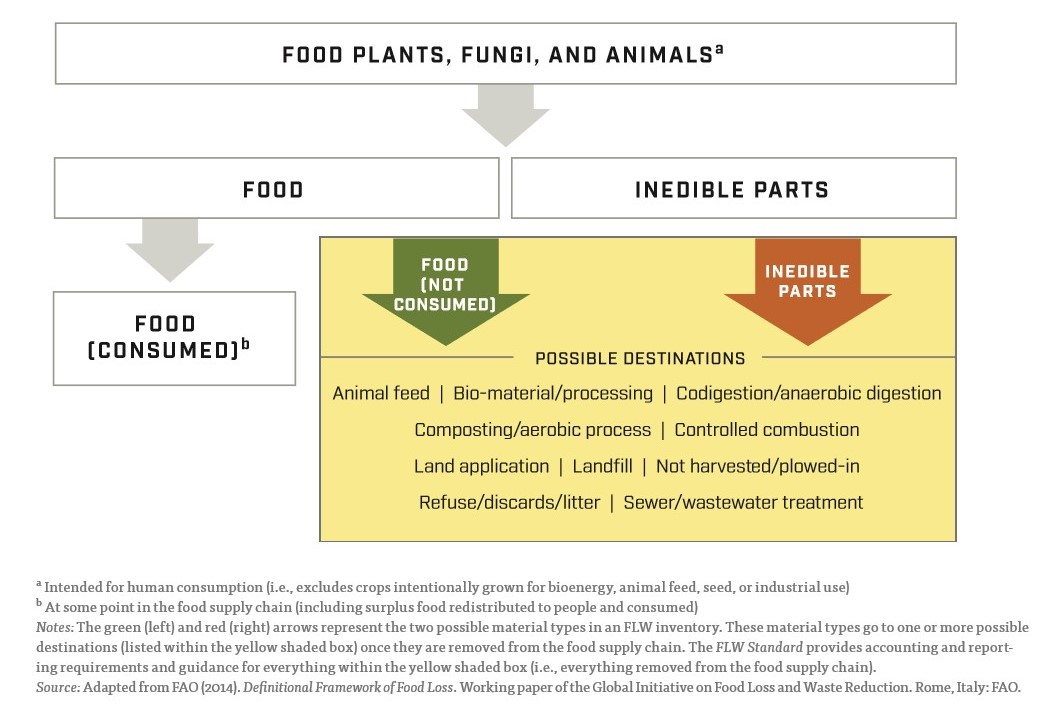
Image: Material types and possible destinations under the Food Loss and Waste Accounting and Reporting Standard7.
3. Global statistics on food waste
The FAO estimates that roughly one third (by weight) of the edible parts of food produced globally for human consumption is lost or wasted1, which is around 1.3 billion tonnes of food loss and waste per year. The WRI converted the same data from weight to calories, finding that 24% of food calories produced for human consumption are lost or wasted6. The difference is partly because fruit and vegetables, which account for 44% of food loss and waste by weight, have relatively few calories per unit weight compared to other food groups.
The FAO’s figure does not include inedible parts of food products, products destined for animal feed, or losses during the production of said animal feed. It does include loss and wastage during agricultural production (e.g. damage during harvest, discarded fish, and decreased milk production due to dairy cow sickness), post-harvest handling and storage, processing, distribution, and consumption (including in households). The estimate was produced by combining the FAO’s Food Balance Sheets with data from a literature search on global food waste and estimates to cover gaps in knowledge.
Levels and types of food loss and waste vary between regions (see figure below). The fraction of food losses and waste occurring at the consumer stage is relatively high in North America and Oceania, Europe, and Industrialised Asia (Japan, China and South Korea), compared to other regions. Levels of food losses and waste occurring from production to retailing are similar across most regions1.
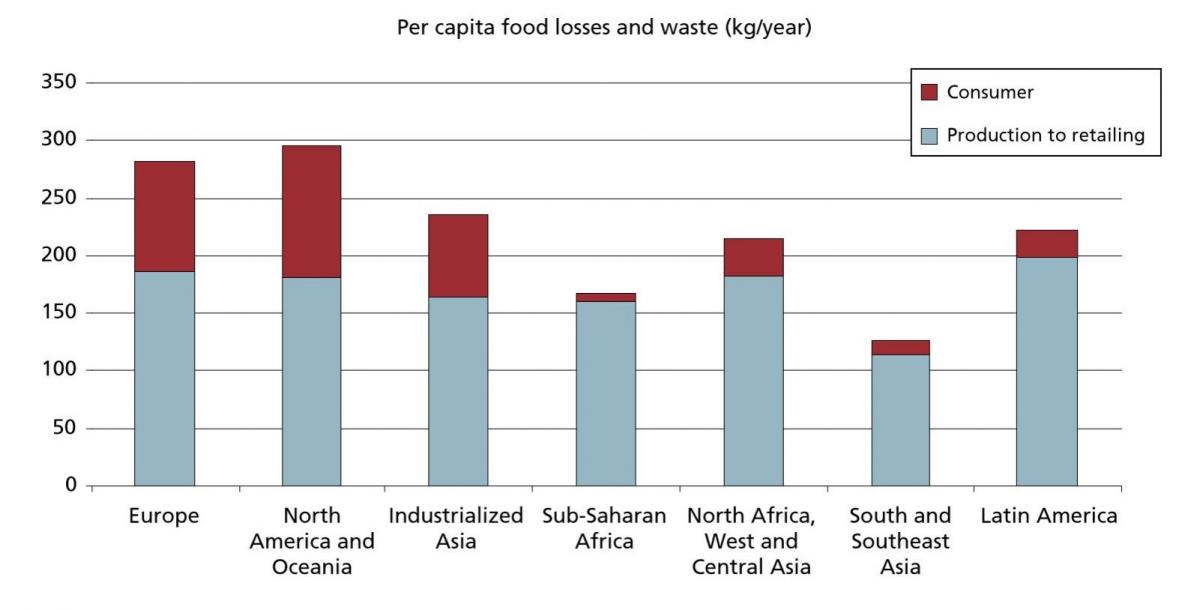
Image: Figure 2, FAO (2011)1. Per capita food losses and waste, at consumption and pre-consumption stages, in different regions.
The study notes that the drivers of food loss and waste vary between countries depending on income1.
In higher income countries, reasons for food being lost or wasted include:
- Farmers producing more than necessary to ensure they fulfil their supply contracts.
- Strict quality standards that lead to edible food not being offered for sale.
- Trimming of food during processing.
- Large quantities of food and many brands being displayed in shops, with some food expiring before it can be sold.
- People on average being more able to afford to waste food than in lower income countries, since food constitutes a relatively small part of household expenditure8 and there is an abundance of food available in restaurants and stores, which can encourage people to buy more food than they can eat.
In lower income countries, reasons for food being lost or wasted include:
- Crops being harvested too early (due to need for money or food), which can make them unsuitable for consumption.
- Poor dry or refrigerated storage infrastructure.
- Insufficient industry capacity for processing and preserving food.
- Unsanitary conditions in wholesale or retail markets.
In lower income countries, consumer-level food waste is relatively rare, because many people cannot afford to waste food. Furthermore, people often only buy the food they need for the day of purchase.
Evans and Welch9 point out that the drivers of food waste extend beyond the behaviour of individuals into household dynamics, cultural expectations and social organisation. For example, meals eaten with other household members are twice as likely to result in leftovers than meals eaten alone. Meanwhile, surplus food can be generated if consumers have little control over the portion sizes they buy, e.g. if they have to choose between buying a pack of three peppers or none at all. Evans and Welch also note that surplus food is more likely to become wasted food when a relatively small fraction of a meal is left over (e.g. a meal with less than 10% left over is 130 times more likely to result in wasted food than a meal with 30-50% left over).
Alexander et al. mapped the flow of food through different stages of the food supply chain10. As shown in the figure below, 24% of the dry biomass harvested from crops and grassland (some of which is edible to humans, and some of which is not) is consumed as food by people.
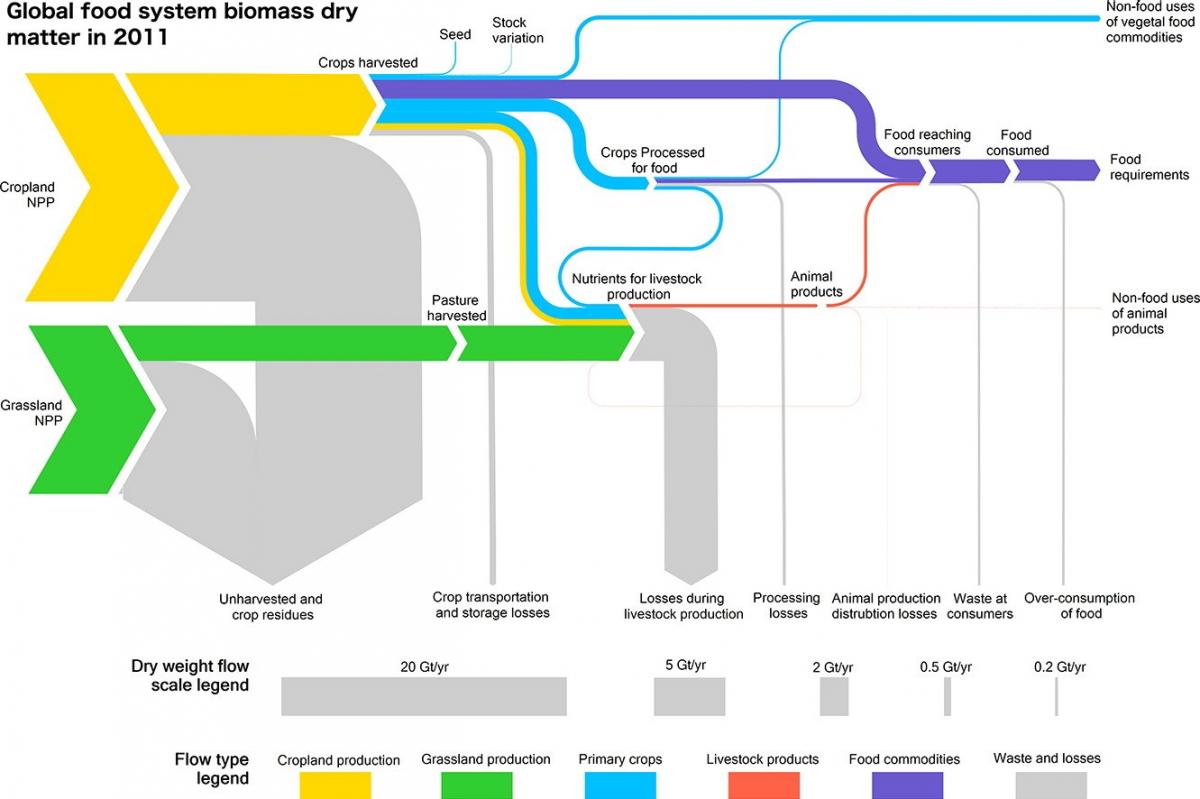
Image: Graphical abstract, Alexander et al. (2017)10. Global food system biomass dry matter in 2011. NPP = net primary production.
Only around 22% (rather than 24% as mentioned above) of the biomass harvested from crops and grassland is consumed as necessary human nutrition. This is because 10% of food eaten by people is surplus to minimum nutritional requirements (defined as intake greater than 2342 kcal/person/day and 52 g/person/day of protein). These minimum requirements are estimated for the whole population, rather than for individuals.
The amount of food required for human nutrition (i.e. 90% of the food actually eaten) is 1.49 Gt (dry biomass), which is only 22% of the 6.81 Gt harvested from crops and grassland. The loss of 5.32 Gt between the two points can be attributed to several different causes, as shown in the table below. 3.76 Gt is lost during livestock production (71% of the total loss between the two points), 0.44 Gt (8%) is lost during distribution, 0.22 Gt (4%) during processing, 0.17 Gt (3%) through over-consumption of food by people, 0.16 Gt (3%) due to consumer-level food waste, and 0.56 Gt (11%) goes towards non-food purposes, is used for seed, or is added to existing stocks of food.
Table: Dry biomass losses throughout the food supply chain. Data from Alexander et al. (2017)10.
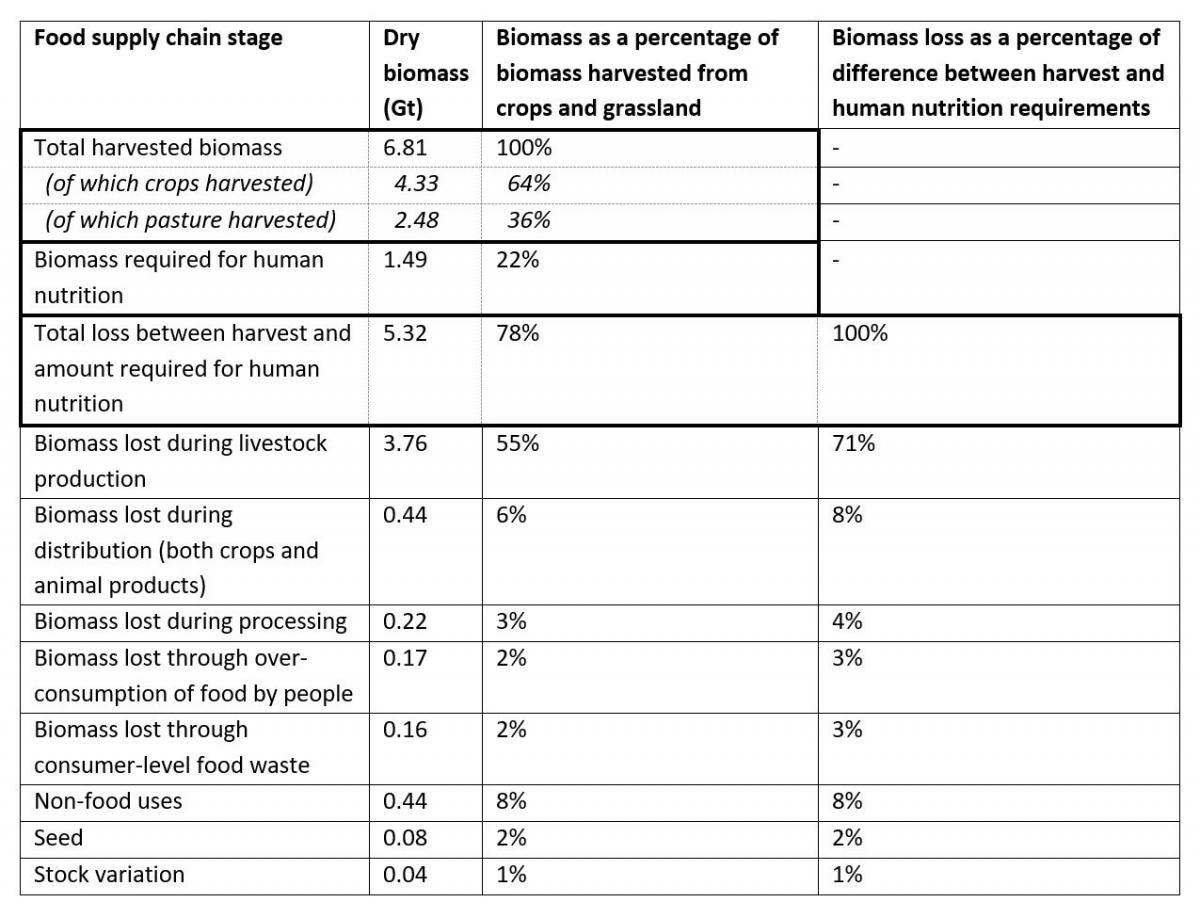
The environmental impacts of the food system are higher than they need to be than if food loss and waste were lower. Each year, globally, food that is produced for human consumption but that is lost or wasted causes 3.3 Gt CO2 eq. of greenhouse gas emissions excluding emissions from land use change (compared to, very roughly, 10 to 15 Gt CO2 eq. annual emissions from the whole food system, based on 20-30%11 of 49 Gt CO2 annual anthropogenic emissions12), consumes 250 km3 of surface water and groundwater, and uses 1.4 billion hectares of land, which is around 30% of global agricultural land area13.
4. Other understandings of food loss and waste
Some interpretations of what should or should not count as food loss or waste are very different from the mainstream definitions outlined in Section 2.
‘Avoidable’ food waste
‘Inedible’ parts of food products are not included in the FAO’s definition of food loss or waste. However, the parts of food that are eaten may vary between cultures, individuals or food preparation method. For example, people may not be accustomed to eating broccoli stems or chicken feet; increasingly today many people prefer not to eat animal fat; and consumption of offal has been falling14. Furthermore, as processing technology develops, it may become possible to extract nutrition from previously inedible by-products. For example, the 2018 discovery of the cause of bitterness in rapeseed protein isolates could eventually allow these by-products to be used as food for humans, in addition to rapeseed’s existing use as animal feed15.
Harvest-level waste
Food that could be harvested, but that is not, is only included within some food waste and loss definitions. The WRI, for example, considers food loss to cover crops that are not harvested because they do not meet quality standards or are not profitable to harvest6. The FAO defines food damaged during harvest, products that are lost prior to harvest (e.g. through livestock disease) and products discarded after harvest due to quality control as forms of food loss, but it is not clear whether the definition includes ripe crops that are not harvested for economic reasons. UK charity Feedback argues that harvest-level waste should be defined as food waste because, for many food types, most of the environmental impacts occur prior to harvest. Not defining harvest-level food waste as waste could encourage organisations to reduce, say, retail-level waste even if that reduction meant that unreported harvest-level waste increased16. However, there are other factors to consider: for example, ploughing crops into the ground may be beneficial to the soil17. Around 73% of crop biomass is either crop residue or unharvested crops, but it isn’t clear what proportion could have been edible if it had been harvested10.
Feeding human-edible food to animals
An estimated 14% of animal feed, globally, is suitable for human consumption (measured as dry matter)18, although Alexander et al. find that 21% of animal feed is from crops10. Around 40% of global arable land is used to produce animal feed1818.
Human-edible food grown intentionally as animal feed is not generally counted as food loss or waste. However, animals always produce a lower amount of food (whether measured by dry mass, energy or protein) than they consume through feed (including both feed crops and grazing) because a portion of the feed is used by the animal’s body for movement and maintenance, contributes to growing inedible body parts, or is excreted. Therefore, if an animal eats exclusively human-edible feed, it produces less food for humans than it consumes. This perceived inefficiency has led some to argue that it is wasteful to feed human-edible food to livestock19,20.
The efficiency (or otherwise) of feed conversion is commonly illustrated by the Feed Conversion Ratio (FCR), which is the ratio of feed mass to the resulting livestock mass. As an example, pigs typically need to consume 2.7 to 5.0 kg of feed to increase their body weight by 1 kg21. However, the FCR has some limitations: it does not account for the fraction of livestock weight that is edible by humans2,21 (for example, only around 55% of a cow’s live weight is available as meat22) and it does not distinguish between human-edible and human-inedible feed18.
Cassidy et al. do account for the fraction of livestock weight that is edible by humans in their assessment of how crops are used in the global food system. They find that 36% of crop calories are used as animal feed. After conversion to food during livestock production, only 4% of crop calories are available as human-edible animal products. In total, 59% of crop calories grown are available for human consumption – the 55% of calories in crops grown for direct human consumption plus the 4% embedded in animal products (the remaining 9% are used for non-food purposes). Cassidy et al. estimate that growing food exclusively for human consumption (as opposed to animal feed or other uses such as biofuels) would increase calorie availability by 70% (enough to feed another 4 billion people) and double protein availability2.
There is often a difference in quality between food-grade and feed-grade crops such as maize, barley or soy, so feeding fewer feed-grade crops to animals might not make an equal quantity of human-grade food available. However, many feed-grade crops are suitable for human consumption, although they may have different properties to food-grade crops. Feed-grade wheat, for example, might produce a different texture of bread to that produced using breadmaking varieties23.
The capture and processing of wild fish into fishmeal and fish oil for use in fed aquaculture (as in reduction fisheries) is regarded as wasteful by some commentaters24,25,26,27, particularly because some of the species targeted could be eaten directly by humans, e.g. Atlantic herring. Many of the species targeted for use as fishmeal are not normally eaten directly by people, e.g. sand eels, although in principle they are edible. Around one sixth of the catch of wild fisheries is processed into fishmeal or fish oil28.
Feeding human-inedible food to animals
Bellemare et al. argue that lost or wasted food that is later recovered for any “productive use” should not be regarded as food waste29: “…if recovered food is used as an input, such as animal feed, fertilizer, or biomass to produce output, then by definition it is not wasted.”
Similarly, Stuart suggests that cultures where food scraps are commonly fed to animals may regard food waste as less problematic (compared to cultures without such a tradition), because the animals convert the waste stream into human-edible food30.
Many countries, such as Japan and South Korea, feed heat-treated food losses to animals31. However, feeding some forms of food waste to animals is currently illegal in some countries. For example, the European Union (EU) currently bans feeding catering waste to animals following the 2001 outbreak of Foot and Mouth Disease32. UK food waste charity Feedback has campaigned for a return to feeding food waste to pigs in the UK33, arguing that it would be safe provided the waste was heat-treated in regulated facilities34. According to Ermgassen et al., introducing centralised processing of food waste into animal feed could reduce the land used by EU pork production by 20%, saving 1.8 million hectares of farmland35.
The ‘ecological leftovers’ approach to livestock would only feed human-inedible food to livestock, i.e. crop residues, grass, food waste and food processing by-products36. This could provide 9 to 23 grams of animal protein per person per day (out of a 50 to 60 grams daily total protein requirement)37.
Around 700 million hectares of the 2 billion hectares currently used as grassland for livestock could be converted to cropland18. Therefore, an argument could be made that even although the grass produced by those 700 million hectares of land (equivalent in area to half of current arable land) is not edible to humans, it is ‘wasteful’ to use the land for livestock production when crops could be grown directly for human consumption instead. However, converting grassland to cropland is likely to release carbon from soils38, showing that many competing objectives must be balanced when considering land use.
Using human-edible food for biofuel or other industrial uses
9% of calories from crops are used for biofuel or other industrial uses and are therefore lost from the food system2. Arguably, this loss to the food system could be defined as food waste, although mainstream definitions do not do so (see Section 2 above).
Fish discards
Fish discards, i.e. fish that are thrown back into the ocean after being caught (for example due to not being the target species), are included in the FAO’s estimate that one third of food is lost or wasted. Estimates of fish discard levels range from 8% to 20% of catches39,40. However, it is difficult to estimate the true levels of fish discards because they are often unreported.
Consumption of food surplus to requirements
As discussed above, it has been estimated that eating more food than necessary (defined as intake greater than 2342 kcal/person/day and 52 g/person/day of protein) accounts for a similar level of food loss as consumer-level food waste10. Consuming more calories than required can cause a person to become overweight or obese, increasing the risk of several non-communicable diseases41(see the building block What is malnutrition?). However, those who eat food surplus to average estimated minimum nutritional requirements are not necessarily overweight – for example, highly active people might eat more than average.
It may be regarded as problematic to define over-eating as a form of food waste, particularly in view of the social stigma surrounding people who are overweight or obese (see What is malnutrition?). Furthermore, the enjoyment of eating food, even if surplus to nutritional requirements, could be regarded as a valid output of the food system14. Alternatively, if the aim of the food system were solely to be defined as providing sufficient and sufficiently nutritious food at minimum environmental cost, then consumption of food surplus to nutritional requirements could indeed be regarded as a form of food waste41.
Food waste as a buffer against food insecurity
Some practices have been viewed as wasteful of food by some observers. For example, potlatch, a gift-giving ceremony traditionally practiced by some peoples of the Northwest Coast of North America, was outlawed by the Canadian government between 1884 and 1951 because it was perceived as wasteful of food and other goods42.
However, an alternative interpretation is that so-called ‘wasteful’ practices are a buffer against hunger, since the ‘wasteful’ practice establishes a production capacity greater than normal requirements, giving a safety margin when crops fail. Stuart draws parallels with the global modern food system, suggesting that food aid donations, overconsumption, feeding of livestock and food waste all act as outlets for surplus food production – but he also notes that surplus production in today’s world causes unnecessary harm to the environment30.
Waste of nutrients
The FAO considers decreases in food quality to be a type of food loss4. Since nutrient levels in food can be decreased by processing, cooking or time in storage, these processes could conceivably be regarded as causing food loss. For example, whole wheat contains higher levels of several vitamins than milled wheat43, while broccoli and spinach can lose over half their vitamin C when cooked44.
Pet food
The FAO only considers food intended for human consumption within its definitions of food loss and waste. However, companion animals consume significant quantities of food. In the United States, cats and dogs consume 19% of the dietary energy and 33% of the animal-derived energy that humans do45. In the UK, animal-based pet food must come from animal parts that are legally suitable for human consumption23, but much pet food uses offal that is no longer popular in some markets46. This use of offal could be regarded as a good use of low-value by-products14. However, it could be argued that it is wasteful to have pets at all, particularly carnivorous pets. Another trend that could be considered wasteful of food is the rise in availability of ‘premium’ pet foods, such as chilled foods or primes cuts of meat14.
5. Hierarchies of food loss and waste
Food loss and waste ‘hierarchies’ specify a preferred order in which solutions for avoiding or treating lost or wasted food are applied. For example, the UK legally obliges companies to use the food waste hierarchy described below, which covers (in order from most to least preferred) waste prevention, redistribution of food to people, animal feed, recycling, energy recovery and disposal47. Preventing food loss and waste in the first place, for example through different refrigeration or packaging practices, would mean lower food production levels are required, lessening the environmental impacts of the food system. Failing that, redistribution of food to people or as animal feed still provides nutrition for people. The least preferred options, such as landfill or incineration without energy recovery, do not recover resources and may also cause environmental impacts such as air pollution, water pollution or methane emissions as food degrades in landfill48. Feedback points out that edible food is sometimes sent to anaerobic digestion plants instead of feeding people in need, contrary to the preferences of this hierarchy49.
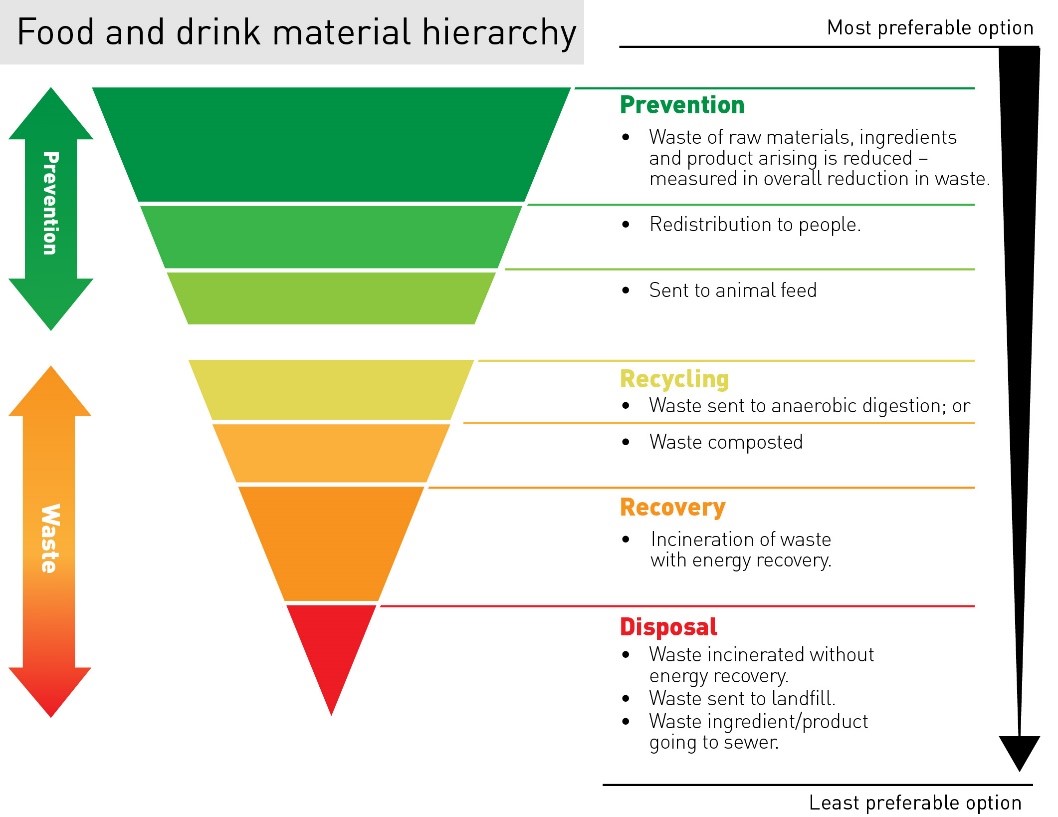
Image: WRAP47. Food and Drink Material Hierarchy.
Alternative hierarchies exist. For example, the flowchart below relies on the distinctions between food surplus (which is still fit for human consumption) and food waste (in this case defined as not fit for human consumption), and between avoidable and unavoidable food waste50.
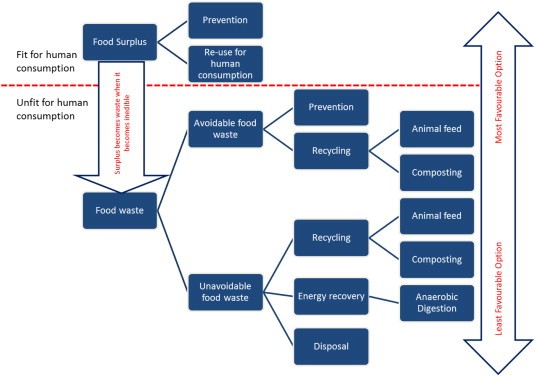
Image: Papargyropoulou et al. (2014)50, Figure 4, Food surplus and waste framework.
Although redistribution of food that would otherwise go to waste can – in the short term – help people who are food insecure, there is some controversy over whether food redistribution is beneficial in the long term. For example, it has been suggested that focusing on donating surplus food to people at risk of hunger could reduce the incentive for governments to find systemic solutions to both food waste and food insecurity51. Furthermore, food donations might not be able to provide a reliably nutritious diet,52.
Rasmussen et al. argue53 that basing a waste hierarchy (not necessarily for food alone) on environmental benefits neglects the fact that some environmentally preferable solutions may come at greater social or economic cost (or vice versa). Social costs include both direct financial costs and the ‘value’ of environmental damage, such as polluted air. One of many cases cited by Rasmussen et al. is a 1997 study that found composting waste has higher social costs than landfill54. Therefore, they argue, the “waste hierarchy must be considered a very general and flexible guideline for formulating waste policies”53.
Choosing between different uses for food waste involves assessing opportunity costs, i.e. the benefits foregone by not using a resource for another purpose. For example, composting pineapple leaves means that they can no longer be used to create textiles55. In this case, the opportunity cost could be measured as the difference between profit that could have been made by creating textiles and the profit (if any) that could be made by composting the leaves. Similarly, if a waste stream such as corn flakes can be used for more than one purpose (such as brewing beer or feeding animals56), pursuing either course of action may involve opportunity costs relative to pursuing the other.
The hierarchies described above do not account for all of the possible definitions of food loss and food waste – for example, overconsumption – which means that there may be ways of reducing food losses that are not covered by the hierarchies.
Furthermore, the hierarchies do not account for the rebound effect, i.e. the system-wide changes that may result from a reduction in food waste. If people save money by wasting and buying less food, that money could be spent on alternative products, such as different food brands, flights or clothing. For example, WRAP estimated that when UK consumers save money through food waste reduction, they spend around half of the saved money on ‘trading up’ to more expensive foods57. The alternative products may have a greater or lesser impact on the environment than the ‘saved’ food would have had, so there is no guarantee that reducing food waste results in less damage to the environment. For further discussion of the rebound effect, see the FCRN report Cooking up a storm58 and WRAP (2009)59.
6. Related concepts
Efficiency
Efficiency refers to the ratio between a desired output (such as food) and a certain input (e.g. land area) or by-product (e.g. greenhouse gas emissions). For further discussion of the concept of efficiency in food systems, see the FCRN report Lean, green, mean, obscene…?
Opportunity cost
Sometimes using a waste stream for one purpose means that it cannot be used for another, such as choosing between composting food waste or feeding it to animals (although there are cases in which multiple products can be extracted from a single waste stream, such as extracting limonene, ethanol and feed pellets from waste citrus fruit60). The opportunity cost of a course of action refers to benefits foregone by not taking another course of action.
Circular economy
The ‘circular economy’ is a concept whereby waste resource streams are transformed into usable products again, instead of being discarded after one use as would happen in a ‘linear’ economy. Reduction of those waste streams in the first place is not necessary for an economy to be circular. Currently, only around 9% of material waste streams in the global economy are recycled61.
Download the PDF version of this explainer here.
-
1
FAO- Food and Agriculture Organization of the United Nations. Global food losses and food waste: extent, causes and prevention. in Save Food! Global Food Losses and Food Waste (2011). doi:10.1098/rstb.2010.0126
- 1
- 1
- 1
- 1
- 1
-
2
Cassidy, E. S., West, P. C., Gerber, J. S. & Foley, J. A. Redefining agricultural yields: From tonnes to people nourished per hectare. Environ. Res. Lett. (2013). doi:10.1088/1748-9326/8/3/034015
- 2
- 2
-
3
International Food Policy Research Institute. Global Nutrition Report 2016: From Promise to Impact: Ending Malnutrition by 2030. (2016). doi:10.2499/9780896295841
-
4
Food and Agriculture Organization of the United Nations. Food waste | Technical Platform on the Measurement and Reduction of Food Loss and Waste | Food and Agriculture Organization of the United Nations. Archived web page available at: https://web.archive.org/web/20190317184453/http://www.fao.org/platform-food-loss-waste/food-waste/definition/en. (Original web page accessed: 26th February 2019)
- 4
-
5
Food and Agriculture Organization of the United Nations. Food loss | Technical Platform on the Measurement and Reduction of Food Loss and Waste | Food and Agriculture Organization of the United Nations. Archived web page available at: https://web.archive.org/web/20190315102900/http://www.fao.org/platform-food-loss-waste/food-loss/definition/en. (Original web page accessed: 26th February 2019)
-
6
Lipinski, B. et al. Creating a Sustainable Food Future: Reducing Food Loss and Waste. World Resour. Inst. (2013). doi:10.2499/9780896295827_03
- 6
- 6
-
7
WRI. Food Loss and Waste Accounting and Reporting Standard. FLW Protoc. (2016). doi:10.3109/09638280902918738
- 7
-
8
Alex Gray. This map shows how much each country spends on food. World Economic Forum (2016). Available at: https://www.weforum.org/agenda/2016/12/this-map-shows-how-much-each-country-spends-on-food/. (Accessed: 26th February 2019)
-
9
Evans, D. & Welch, D. CONSUMPTION, RETAIL AND COLLABORATION TOWARDS A SUSTAINABLE FOOD SYSTEM. Sustain. Consum. Inst. (2015). doi:10.1016/0306-4549(82)90023-8
-
10
Alexander, P. et al. Losses, inefficiencies and waste in the global food system. Agric. Syst. (2017). doi:10.1016/j.agsy.2017.01.014
- 10
- 10
- 10
- 10
- 10
-
11
Food Climate Research Network. 3.1 What is the food system’s contribution to the global GHG emissions total? Foodsource
-
12
Intergovernmental Panel on Climate Change. Climate Change 2014 Synthesis Report - IPCC. Climate Change 2014: Synthesis Report. Contribution of Working Groups I, II and III to the Fifth Assessment Report of the Intergovernmental Panel on Climate Change (2014). doi:10.1017/CBO9781107415324
-
13
FAO. Food wastage footprint. Impacts on natural resources. Food wastage footprint Impacts on natural resources (2013). doi:ISBN 978-92-5-107752-8
-
14
Garnett, T., Röös, E. & Little, D. Lean, green, mean, obscene…? What is efficiency? And is it sustainable? (2015).
- 14
- 14
- 14
-
15
Hald, C., Dawid, C., Tressel, R. & Hofmann, T. Kaempferol 3- O-(2- O-Sinapoyl-β-sophoroside) Causes the Undesired Bitter Taste of Canola/Rapeseed Protein Isolates. J. Agric. Food Chem. (2019). doi:10.1021/acs.jafc.8b06260
-
16
Feedback. Consultation response to European Commission on EU food waste methodology. (2018).
-
17
Terry, L., Mena, C., Williams, A., Jenny, N. & Whitehead, P. Fruit and vegetable resource maps. WRAP (2011). doi:10.1016/j.icrp.2009.12.007
-
18
Mottet, A. et al. Livestock: On our plates or eating at our table? A new analysis of the feed/food debate. Global Food Security (2017). doi:10.1016/j.gfs.2017.01.001
- 18
- 18
-
19
Stevenson, P. Industrial Livestock Production: The Twin Myths of Efficiency and Necessity Peter Stevenson Compassion in World Farming. UFAW Conf. (2015).
-
20
Kikou, O. The EU’s promotion of meat consumption is misguided, Mr Hogan. Euractiv (2016). Available at: https://www.euractiv.com/section/agriculture-food/opinion/the-eus-promotion-of-meat-consumption-is-misguided-mr-hogan/. (Accessed: 26th February 2019)
-
21
Fry, J. P., Mailloux, N. A., Love, D. C., Milli, M. C. & Cao, L. Feed conversion efficiency in aquaculture: Do we measure it correctly? Environ. Res. Lett. (2018). doi:10.1088/1748-9326/aaa273
-
22
Williams, A. G., Audsley, E. & Sandars, D. L. Determining the environmental burdens and resource use in the production of agricultural and horticultural commodities’ by Williams et al 2006 at Cranfield University and the Silsoe Research Institute. Main Report. Defra Research Project IS0205. Bedford: Cranfield University and Defra. (2006).
-
23
Garnett, T. Meat and dairy production & consumption. (2007).
- 23
-
24
Bland, A. Waste Not, Want Not: Drink Beer To Feed Fish And Help Save The Planet. NPR (2017). Available at: https://www.npr.org/sections/thesalt/2017/12/12/569399249/waste-not-want-not-drink-beer-to-feed-fish-and-help-save-the-planet?t=1551212023438. (Accessed: 26th February 2019)
-
25
Cressey, D. Farmed fish drive sea change in global consumption. Nature (2016). doi:10.1038/nature.2016.20223
-
26
Mood, A. & Brooke, P. Estimating the Number of Farmed Fish Killed in Global Aquaculture Each Year. FishCount (2012).
-
27
Sea Shepherd UK. We Need to Stop Eating the Oceans. Available at: https://www.seashepherd.org.uk/news-and-commentary/commentary/we-need-to-stop-eating-the-oceans.html. (Accessed: 26th February 2019)
-
28
Cashion, T., Tyedmers, P. & Parker, R. W. R. Global reduction fisheries and their products in the context of sustainable limits. Fish Fish. (2017). doi:10.1111/faf.12222
-
29
Bellemare, M. F., Çakir, M., Peterson, H. H., Novak, L. & Rudi, J. On the Measurement of Food Waste. in American Journal of Agricultural Economics (2017). doi:10.1093/ajae/aax034
-
30
Stuart, T. Waste: Uncovering the global food scandal. (Penguin Books, 2009).
- 30
-
31
zu Ermgassen, E. K. H. J., Kelly, M., Bladon, E., Salemdeeb, R. & Balmford, A. Support amongst UK pig farmers and agricultural stakeholders for the use of food losses in animal feed. PLoS One (2018). doi:10.1371/journal.pone.0196288
-
32
The Pig Idea. The Solution. Available at: http://www.thepigidea.org/the-solution.html. (Accessed: 26th February 2019)
-
33
The Pig Idea. The Pig Idea. Available at: http://www.thepigidea.org/. (Accessed: 26th February 2019)
-
34
Luyckx, K. & Bowman, M. Feeding surplus food to pigs safely. (2018).
-
35
zu Ermgassen, E. K. H. J., Phalan, B., Green, R. E. & Balmford, A. Reducing the land use of EU pork production: Where there’s swill, there’s a way. Food Policy (2016). doi:10.1016/j.foodpol.2015.11.001
-
36
Garnett, T. Livestock-related greenhouse gas emissions: impacts and options for policy makers. Environ. Sci. Policy (2009). doi:10.1016/j.envsci.2009.01.006
-
37
Van Zanten, H. H. E. et al. Defining a land boundary for sustainable livestock consumption. Global Change Biology (2018). doi:10.1111/gcb.14321
-
38
Garnett, T. et al. Grazed and confused? Ruminating on cattle, grazing systems, methane, nitrous oxide, the soil carbon sequestration question – and what it all means for greenhouse gas emissions. (2017).
-
39
Zeller, D., Cashion, T., Palomares, M. & Pauly, D. Global marine fisheries discards: A synthesis of reconstructed data. Fish Fish. (2018). doi:10.1111/faf.12233
-
40
Kelleher, K. Discards in the world’s marine fisheries. An update. FAO Technical Paper No. 470. FAO Tech. Pap. No. 470 (2005). doi:10.1136/ebmed-2011-0012
-
41
Alexander, P. & Moran, D. Rethinking food waste for a healthier planet. Lancet Planet. Heal. (2017). doi:10.1016/s2542-5196(17)30077-3
- 41
-
42
Gadacz, R. R. Potlatch | The Canadian Encyclopedia. (2006). Available at: https://www.thecanadianencyclopedia.ca/en/article/potlatch. (Accessed: 26th February 2019)
-
43
Henry*, C. J. K. & Heppell, N. Nutritional losses and gains during processing: future problems and issues†. Proc. Nutr. Soc. (2008). doi:10.1079/pns2001142
-
44
Zeng, C. Effects of different cooking methods on the vitamin C content of selected vegetables. Nutr. Food Sci. (2013). doi:10.1108/NFS-11-2012-0123
-
45
Okin, G. S. & Crowther, M. S. Environmental impacts of food consumption by dogs and cats. PLoS One (2017). doi:10.1371/journal.pone.0181301
-
46
WWF. What’s the environmental impact of pet food? World Wildlife Magazine (2016). Available at: https://www.worldwildlife.org/magazine/issues/spring-2016/articles/what-s-the-environmental-impact-of-pet-food. (Accessed: 26th February 2019)
-
47
WRAP UK. Why take action: legal/policy case. Available at: http://www.wrap.org.uk/content/why-take-action-legalpolicy-case. (Accessed: 26th February 2019)
- 47
-
48
Vision 2020. Why ban food waste from landfill? Available at: https://www.vision2020.info/ban-food-waste/. (Accessed: 26th February 2019)
-
49
Colbert, E., Schein, A., Douglas, D. & O’Sullivan, C. Causes of food waste in international supply chains. (2017).
-
50
Papargyropoulou, E., Lozano, R., K. Steinberger, J., Wright, N. & Ujang, Z. Bin. The food waste hierarchy as a framework for the management of food surplus and food waste. J. Clean. Prod. (2014). doi:10.1016/j.jclepro.2014.04.020
- 50
-
51
Caraher, M. & Furey, S. Is it appropriate to use surplus food to feed people in hunger? Short-term Band-Aid to more deep-rooted problems of poverty. Food Research Collaboration (2017). doi:http://dx.doi.org/10.1016/j.ejor.2016.08.065
-
52
Caraher, M. Why giving surplus food to charities is not a solution to food poverty. The Conversation (2017). Available at: https://theconversation.com/why-giving-surplus-food-to-charities-is-not-a-solution-to-food-poverty-72210. (Accessed: 26th February 2019)
-
53
Rasmussen, C. et al. Rethinking the Waste Hierarchy. (2005).
- 53
-
54
Brisson, I. E. Assessing the ‘Waste Hierarchy’ a social cost-benefit analyse of MSW management in the European Union. (1997).
-
55
Piñatex. About Us - Piñatex. Available at: https://www.ananas-anam.com/about-us/. (Accessed: 26th February 2019)
-
56
Hailstone, J. Waste Kellogg’s corn flakes turned into beer. Environment Journal (2018). Available at: https://environmentjournal.online/articles/waste-kelloggs-corn-flakes-to-beer-turned-into-beer/. (Accessed: 26th February 2019)
-
57
Britton, E., Brigdon, A., Parry, A. & LeRoux, S. Econometric modelling and household food waste. (2014).
-
58
Garnett, T. Cooking up a storm and our changing climate. Strategy (2008).
-
59
Scott, K., Barrett, J., Baiocchi, G. & Minx, J. Meeting the UK climate change challenge : The contribution of resource efficiency. WRAP Project EVA128 (2009)
-
60
WRAP. Food Futures: from business as usual to business unusual. (2015).
-
61
Circle Economy. The Circularity Gap report. Circle Economy (2018).





Comments (0)